RMCProfile – II
Introduction
In this
tutorial, we will show how to use GSAS-II in conjunction with RMCProfile
(“RMCProfile: Reverse Monte Carlo for polycrystalline materials”, M.G. Tucker,
D.A. Keen, M.T. Dove, A.L. Goodwin and Q. Hui, (2007) Jour. Phys.: Cond.
Matter, 19, 335218. doi: https://doi.org/10.1088/0953-8984/19/33/335218)
to fit both neutron powder diffraction data and a pair distribution function
(PDF) created from it with a “big box” disordered model.
Before
getting started you must have the most recent Version 6 of the RMCProfile
executable (at this writing this is RMCProfile V6.7.9 although V6.7.6 will also
work, but not any earlier version). Obtain this from www.rmcprofile.org by following the
prompts from Downloads. This version is available for Windows, Mac OSX and
Linux. The download will be a zip file; save it somewhere convenient. Pull from
it only the RMCProfile_package/exe/rmcprofile.exe and the two files in RMCProfile_package/exe/cuda_lib (if present) and place them
in the GSASII main directory or in a new subdirectory (e.g. GSASII/RMCProfile); no other files are needed
although you may wish to also retrieve the contents of the tutorial
subdirectory. It contains rmcprofilemanual.pdf and rmcprofile_tutorial.pdf which may be of interest
since the GSAS-II/RMCProfile tutorials are based on the latter.
The
process for using RMCProfile begins with a normal Rietveld refinement of the
average structure. For the kind of disordered materials of interest here, this
may give bond lengths that are frequently too short for the atoms involved and
sometimes extreme apparent thermal motion for some of the atoms. These effects
arise because the average structure places these atoms too close to one
another; a more localized view would show coordinated atom displacements or
reorientation of groups of atoms to avoid the close contacts. RMCProfile is
then used to characterize these local displacements by fitting to the
diffraction data and its Fourier transform as a PDF.
The
material used in this tutorial is the same as described in the RMCProfile tutorial
Exercise 4, strontium titanate (SrTiO3). In this perovskite the TiO6
octahedra are slightly tilted to accommodate the Ti-O bond length in a slightly
too small unit cell. The data used here was obtained at 190K on the GEM
diffractometer at ISIS, Rutherford-Appleton Laboratory, Harwell Campus, UK. The
process of creating this data introduced two minor flaws: one is a slight
mis-scaling of the magnitudes of the real space, G(R), and reciprocal space,
F(Q), patterns and the other is a difference in the diffractometer constant,
difC, used to make them vs that used for the Rietveld refinement. In this
tutorial we will address both of these in case you encounter them in your
future work with RMCProfile.
If you have not done so already, start GSAS-II.
Rietveld Refinement of Strontium titanate (SrTiO3):
Step 1: Read in the data file
1. Use
the Import/Powder Data/from GSAS powder data file menu item
to read the data file into the current GSAS-II project. This read option is set
to read any of the powder data formats defined for GSAS (angles in
centidegrees, TOF in µsec). Other submenu items will read the cif format or the xye
format (angles in degrees) used by topas, etc.
In those cases, you would change the file type to cif
format or the xye format to see them.
Because you used the Help/Download tutorial menu entry to open this page and
downloaded the exercise files (recommended), then the RMCProfile-II/data/...
entry will bring you to the location where the files have been downloaded. (It
is also possible to download them manually from https://advancedphotonsource.github.io/GSAS-II-tutorials/RMCProfile-II/data/.
In this case you will need to navigate to the download location manually.)
For this tutorial you should see the data file in the file
browser, but if extensions on data files are not the expected ones, you may
need to change the file type to All files (*.*) to
find the desired file.
2. Select the gem05984.gss data file in the first dialog and press Open. There will be a Dialog box asking Is this the file you want? Press Yes button to proceed. The data file contain 4 banks of data

Select
only the third one (BANK 3) and press OK. Next will be a file selection dialog for the instrument
parameter file; only one (GEM.instprm) is shown. Select it; the pattern will be read in and
displayed

This
is a nice pattern showing very little evidence of disorder except that the
three largest peaks appear to have satellite reflections on either side of the
main peak so it is possible that an alternative to what we will be doing here
is to describe the structure as incommensurate with some modulation of the
anticipated small rotations of the TiO6 octahedra.
Step 2. Set limits
The
default limits are set in GSAS-II to be something typical starting at 0.4Å;
there is useful data over the entire range starting at 0.33Å, so let’s use it
all.

On
the plot drag the green dashed line to the left beyond the data; it will snap
to the lowest limit of the data and update the limits table. The upper limit is
fine.
Step 3. Import
SrTiO3 phase
The average structure of SrTiO3 is very simple. Space group I4/mcm, (or Im-3m; a=5.48, c=7.75 with Ti at 0,0,0, Sr at ½,0,¼ and O at 0,0,¼ and .241,.258,0. However, we will save time by importing it from an old gsas experiment file which has anisotropic thermal motion for the O atoms. Use the Import/Phase/from GSAS .EXP file menu item to read the phase information for SrTiO3 into the current GSAS-II project. Other submenu items will read phase information in other formats. Because you used the Help/Download tutorial menu entry to open this page and downloaded the exercise files (recommended), then the RMCProfile-II/data/... entry will bring you to the location where the files have been downloaded. (It is also possible to download them manually from https://advancedphotonsource.github.io/GSAS-II-tutorials/RMCProfile-II/data/. In this case you will need to navigate to the download location manually.) Select the SRTIO3_5K.EXP file (only one there) There will be a Dialog box asking Is this the file you want? Press Yes button to proceed. You will get the opportunity to change the phase name next (change it to ‘SrTiO3’; NB: because of restrictions in RMCProfile it is important that the phase name not have any spaces); press OK to continue. Next is the histogram selection window; this connects the phase to the data so it can be used in subsequent calculations.

Select the histogram (or press Set All) and press OK. The General tab for the phase is shown next

Step 4. Set the
background
Select
the Background item from the GSAS-II data
tree
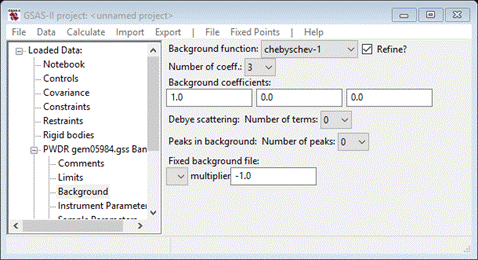
Be
sure that “chebyschev-1” is used for the background function; RMCProfile only
recognizes that form to compute the background for the diffraction pattern.
Select 6 for the number of terms.
Step 5. Rietveld
refinement
We
are now ready for the first Rietveld refinement; select Calculate/Refine from the main GSAS-II menu.
Before it starts a file selection dialog will appear; select a file name (no
extension). I chose “SrTiO3_5K”; do not use the phase name for this purpose because
RMCProfile will use that as the root for the many files it creates. Also, you
should create a new directory for this exercise while in this dialog box; it
will be rapidly filled up with RMCProfile files which can lead to considerable
confusion if mixed in with other files. For Windows, after navigating to a
suitable location, a new directory can be made by a right mouse click and
selecting “New/Folder” from the popup menu. It will appear with the name “New
Folder”; change the name and select it (it will be empty). Other operating
systems will have similar methods. Finally press OK to save the GSAS-II project
(SrTiO3_5K.gpx) and start the refinement. It will quickly converge to give a
poor Rwp (~44%) mostly because of mismatches in peak positions

It
is evident that the lattice parameter needs adjusting. Go to the General tab for the SrTiO3
phase and select Refine unit cell; repeat Calculate/Refine. The Rwp will improve
(~15.9%) giving

To
finish up add the following parameters:
SrTiO3/Atoms: XU for all four atoms (GSAS-II recognizes that some are fixed
in position); the O atoms should have anisotropic thermal displacements.
SrTiO3/Data: refine microstrain and leave size at 1.0.
PWDR/Instrument Parameters: refine difA, Zero, beta-0, beta-1, sig-0, sig-1 and sig-2 (normally not necessary, but
the available GEM instrument parameter file isn’t current). In any event, the
coefficients difB, beta-q and sig-q must be zero since RMCProfile V6.7.6 Beta Serial does not
know how to use them in computing a powder profile.
Do Calculate/Refine from the main menu; the fit
will improve some more to Rwp ~ 7.24% (you may have to repeat Calculate/Refine
to get to
convergence)
Step 6. Draw
structure
Select
the Phases/
SrTiO3/Draw Atoms
tab; the list will be shown and the four unique atoms drawn on the plot.


To
improve this do the following:
1)
Double click the Style column heading and select ellipsoids; the figure will be redrawn showing
the 50% ellipsoid surfaces (very small!)
2)
Double click the empty upper left box in the Draw Atoms table; both atoms will turn
green and the four table rows will be grey.
3)
Under the menu Edit Figure select Fill unit cell; the figure will be redrawn
showing all atoms in the cell (too many bonds, though).
4)
Double click the Type column heading and select the Ti atom type
5)
Under the menu Edit Figure select Fill CN-sphere; the figure will be redrawn
with six O atoms about all Ti atoms (still too many bonds).
6)
Finally select Draw Options tab, set the Ellipsoid probability all the way to the left
(99%) and change Bond search factor to 0.8; the figure will be redrawn
to show
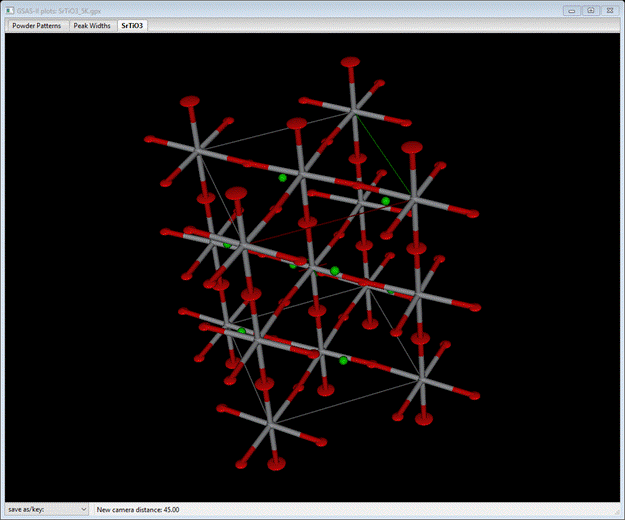
which
is what one expects for some kind of orientational disorder for the TiO6
octahedra. If you look carefully you can see the slight twisting about the
c-axis (that gives the tetragonal perovskite structure), but there is some
additional tilting as well that leads to a disk-like shape to the axial O-atoms
compared to the others. Next we will explore this with a RMCProfile simulation.
To keep this drawing, you may want to save the GSAS-II project.
Reverse Monte Carlo
Simulation of SrTiO3
To start
select the Phases/SrTiO3/RMC tab; if rmcprofile.exe is
within the GSASII directory the data window will show
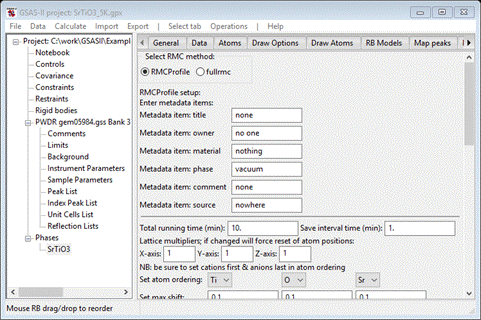
At
the top is a radio button selection for RMCProfile and fullrmc. The latter is an
alternative big box modeling program (not working – under development);
RMCProfile is selected by default and all below are its setup controls. There
are four major sections (metadata, major controls, restraints & constraints
and data controls); we will work through each of these in turn. The information
you enter here is retained in the GSAS-II project so you can easily try
alternative setups without having to enter everything over again.
Step 1. Set
metadata items
The
entries here are for your convenience; there is no explicit use made of any of
these, but they will appear in some of the output files from RMCProfile and of
course will show here on subsequent views of this window. Fill out as many of
them as you see fit. I entered some things for each as the defaults are
somewhat nonsensical.
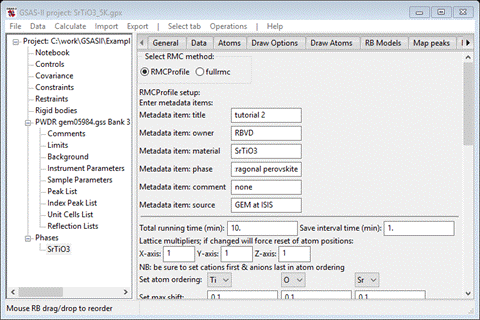
Step 2. Set general
controls
The
running time is defaulted to 10 minutes with a Save interval of 1 minute. At each save time a
number of files are written by RMCProfile; these can be viewed by using the
Operations/Plot command (more about this later – don’t bother trying it now,
there is nothing to see). For the purposes of this tutorial leave them at their
defaults.
The
big box model used by RMCProfile is described as multiples of the unit cell
axes. In this case we want a 6x6x4 box so enter 6 for each of X-axis, Y-axis and 4 for Z-axis.
Next
is to set the order of the atom types in the structure; this is used to
construct atom-atom distance restraints on the modelling. The order here (Ti followed by O and then Sr) isn’t appropriate; if
changed the window will repaint updating various entries possibly resetting
some entries to defaults. I suggest you decide the order now and then don’t
change it later. Change it to Sr, Ti, O; the window will repaint each time. Set the maximum shift
for Sr and Ti to be 0.05 (the value for O is OK). When done the window should look
like
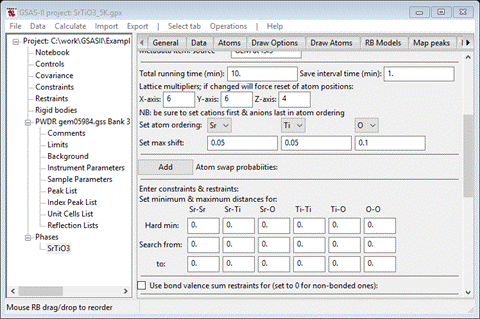
Skip
the next item (Atom swap probabilities). This is for cases in which atoms can
exchange sites.
Step 3. Set
constraints/restraints
Next
is to set the “Hard” minimum atom-atom separation and the allowed search rage for
each of 6 pairs of atom types. Possible values for this table can be obtained
in GSAS-II by computing bond lengths. Select the Atoms tab and then select all
atoms by double clicking on the empty upper left box in the table.

Then
do Compute/Show
distances & angles
from the menu; a popup will appear

Set
the Bond
search factor
to 1.5 and the Angle search
factor to 0.0 (to skip angle
calculations), and press Ok. The console will show a very long table showing all
interatomic distances out to 4-7Å. Find the shortest distance for each of the 6
types of atom pairs in the SrTiO3/RMC data tab. For each one subtract 0.2A and enter the value as
Hard min and Search from. Then add 0.2A and enter
that in the to row. When done the window should look like
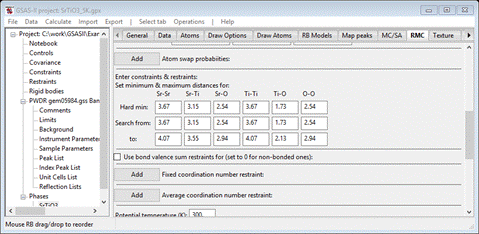
Scroll
down to the bottom of the window for the last section.
Step 4. Select data
to be fitted
We
will be using three different types of SrTiO3 data for the fitting
by RMCProfile. The first is the selection of the powder pattern (“Bragg”) for
processing. This is taken from the PWDR entries in the GSAS-II project and
accessed from the pulldown; there is only one “PWDR gem05984.gss Bank 3” that was used earlier in
your Rietveld refinement of SrTiO3. If you had used multiple banks
in the Rietveld refinement, all would be shown in the pulldown, but only one
can be selected. Set the weight to 0.5 (NB: smaller numbers means a heavier weight).
Next
press the Select button for the “Neutron real space
data; G(R)”
line; a FileDialog should appear. Because you used the Help/Download tutorial
menu entry to open this page and downloaded the exercise files (recommended),
then the RMCProfile-II/data/...
entry will bring you to the location where the files have been downloaded. (It
is also possible to download them manually from https://advancedphotonsource.github.io/GSAS-II-tutorials/RMCProfile-II/data/.
In this case you will need to navigate to the download location manually.)
The
FileDialog should show
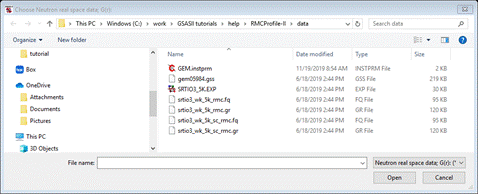
Select
srtio3_wk_5k_rmc.gr; it will be copied from this
location to your working directory for this tutorial (RMCProfile requires all
its files to be local). The window will be redrawn showing the new entry; the
weight is fine.
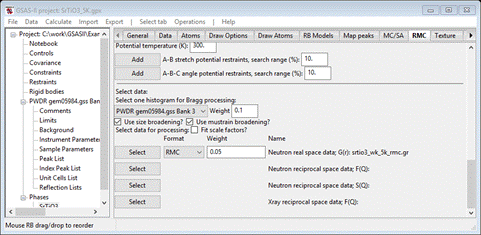
Next
press the Select button for “Neutron reciprocal space data: F(Q)”; the FileDialog will show

Select
srtio3_wk_5k_rmc.fq; again it will be copied to your
working directory. The window will be redrawn
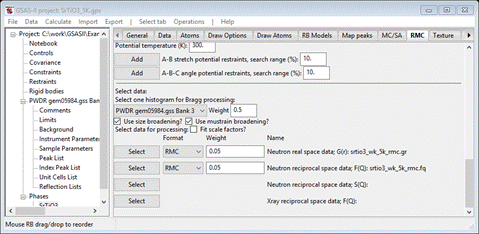
Again,
leave the weight as it is. Your local directory should have just 3 or 4 files
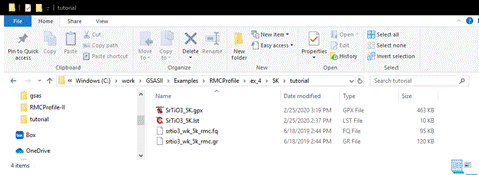
Step 5. Setup
RMCProfile files
You
are now ready to setup the RMCProfile input files.. Do Operations/Setup
RMC from the
menu; the console should report that files were written
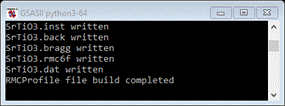
and
your local directory should now have ~8 files

These
text files contain data needed by RMCProfile for the fitting of SF6. They are:
SrTiO3.back- the 6 coefficients for the
chebyschev-1 function needed to compute the background for the Bragg pattern
SrTiO3.bragg – the powder pattern used in
the Rietveld refinement
SrTiO3.dat – the RMCProfile controls
file; described in full in the RMCProfile User Manual. It can be edited if need
be, but remember it is rewritten each time Operations/Setup RMC is done.
SrTiO3.inst – the instrument parameter
coefficients for the neutron TOF peak shape function used by GSAS-II and
implemented in RMCProfile for computing the Bragg pattern.
SrTiO3.rmc6f – the big box set of atom
positions. It is normally not rewritten when Operations/Setup RMC is done
unless the X-axis, Y-axis, or Z-axis lattice multipliers are changed. Most
important is that it will contain the set of big box atom positions as updated
by RMCProfile according to the Save interval (every 1 min in this case).
You
are now ready to run RMCProfile.
Step 6. Run
RMCProfile
To
run RMCProfile from inside GSAS-II, do Operations/Execute. You will first see a “nag”
note asking you to cite the publication describing RMCProfile; press OK.
The
program will start in a new console window – processing will initially be fast
for this case and then slow down as the modelling proceeds. It reports Time
used and Last saved. Once the latter is nonzero you can view intermediate
results to see its progress. It also shows the chi^2 for each of the
contributing data sets; these start in the 5-300 range and will quickly drop in
the initial stages of the run. Note that you can exit GSAS-II and RMCProfile
will continue running. After RMCProfile finishes note that the project
directory now has ~30 files many of which are just temporary ones created by
RMCProfile. We will be looking at just the *.csv files and the SrTiO3.rmcf6
file; the latter contains the last atom configuration acceptable by RMCProfile
thus representing a best disordered model.
A note about
weights:
The
choice of weights for RMCProfile may seem to be arbitrary in these exercises,
but I have selected them so that each of the chi^2 values converge to be
roughly equal and somewhere just above unity. This selection generally gives
the best performance in the reverse Monte Carlo calculation and requires some
“trial & effort” in selecting the values. If one of the chi^2 values is too
large (>>1, i.e. weight too small) at convergence, then adjustments in
the structure will have been dominated by moves that lower that chi^2 sometimes
at the expense of others. Conversely, if one chi^2 is too small (>>1,
i.e. weight too large) then moves will tend to satisfy the others and there
will be little sensitivity to that data set. In this case my chosen weights
have yielded 1.003 for the Bragg, 2.980 for the G(R) “Expt 1” and 1.899 for the
F(Q) “Expt 2” data sets; this is essentially ideal. If they vary by more than
an order of magnitude or are less than unity, you should adjust the weights.
Step 7. Viewing
results from RMCProfile
Do Operations/Plot (you can do this any time
after a save has been done); a FileDialog showing only *.csv files will appear
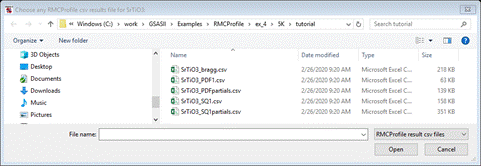
They
all should have the same prefix in their name, “SrTiO3” which is the phase name
from the GSAS-II project file. Select any one of them – it doesn’t matter. All
of them will be read and their contents displayed as individual plots. For
example the chi^2 plot shows the progress of the RMCProfile fit

The
inset is the upper 3/4ths of the plot magnified; you can see that RMCProfile is
still improving the fit slowly even after 10 minutes of running.
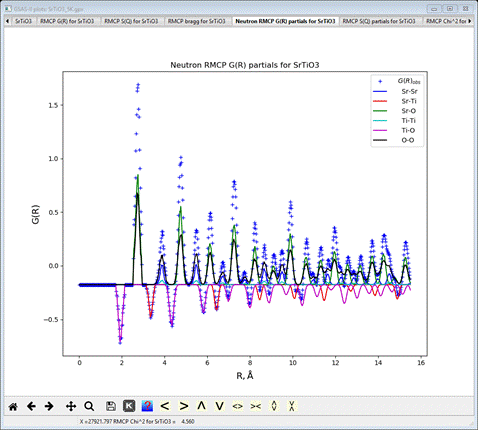
The
G(R) partials plot shows the identity of each feature; because titanium has a
negative neutron scattering length the first sharp peak (1.93Å) is negative and
arises from Ti-O. The next one (2.74Å) is an exact overlap of O-O and Sr-O
distances. One can easily see other peaks involving Ti as well as identify
which atom pairs contribute to every feature of the PDF. Comparing the Bragg plot with the PWDR plot shows that
the RMCProfile fit is very similar to the Rietveld fit
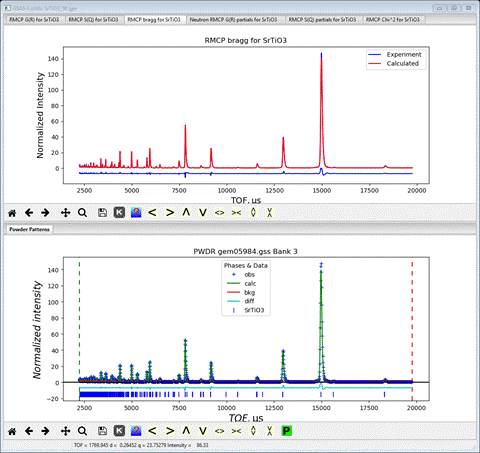
This
plot was made by dragging one plot tab to the bottom of the screen to create
the second frame.
However
if you look at the S(Q) and G(R) plots
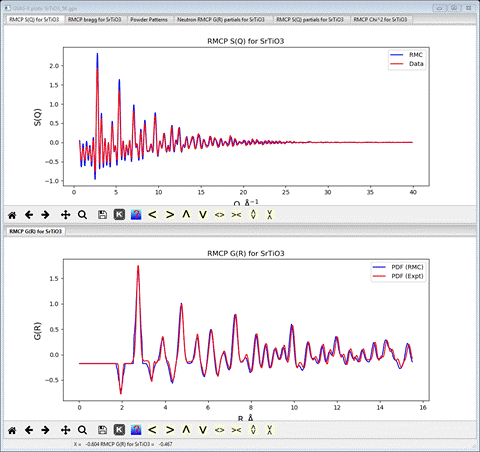
There
are clearly two problems. Both plots have an increasing mismatch for higher R
and Q; one is the reverse of the other. Secondly, there is a scaling issue
especially evident in the S(Q) plot where the data is less than the RMC
calculated result. Both of these issues arise from faults in the data
processing. The scaling can be corrected in RMCProfile but the peak offset must
be fixed first.
Step 8. Fixing peak
offset and allow scaling
The
peak offset in this case arises from different diffractometer constants
(especially difC) used for the Rietveld refinement and the processing for F(Q)
and G(R). To fix this, one must adjust difC and repeat the Rietveld refinement.
This shifts the lattice parameters and ultimately the size of the big box
model. To begin select Instrument Parameters under the PWDR entry in the
GSAS-II data tree (the plot will change to give resolution curves)
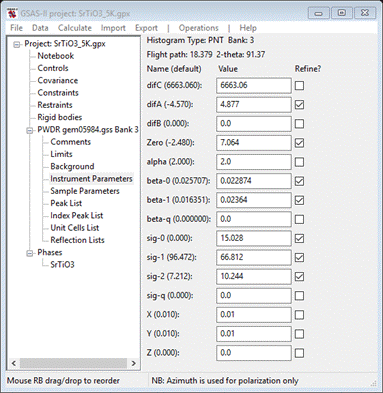
Select
the RMCP
G(R) for SrTiO3
plot and zoom to the highest R end of the plot (I’ve turned on the plot grid –
press ‘g’).
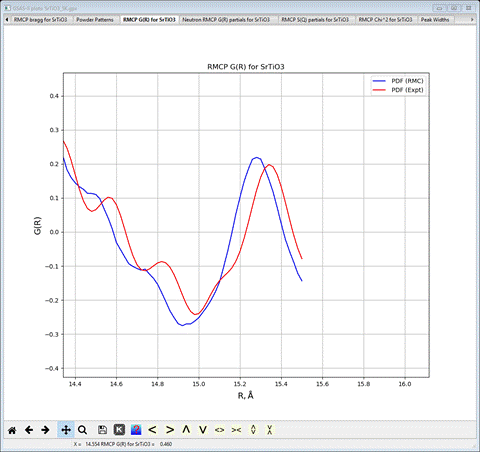
You
want to shift the difC value by the ratio of the RMC/Expt (blue curve/red
curve) peak positions. You can read these from the plot status bar as you
position the cursor on the plot. Enter 6663.06*15.281/15.346 in the difC data field,
GSAS-II will do the math and show the result
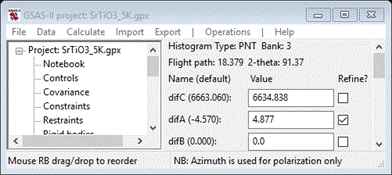
Next
turn off all refinement flags in Instrument Parameters, SrTiO3/Atoms and SrTiO3/Data; then do Calculate/Refine (twice) from the main menu.
The residual will be very poor to begin, but will fall to ~7.19% after the
second set of refinement cycles.
Now
you have to repeat the RMCProfile run starting from a fresh set of lattice
parameters and atom positions. This requires a new SrTiO3.rmc6f file. Select
the SrTiO3/RMC tab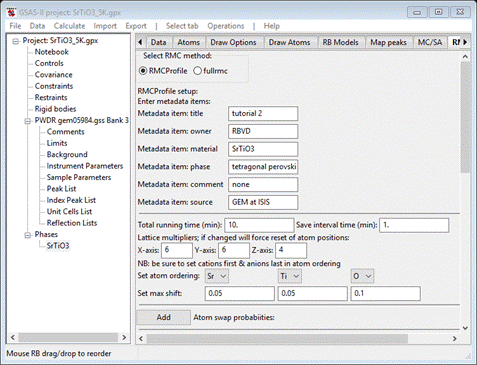
Pick
one of X-axis, Y-axis or Z-axis; change the value to
something else and then back so they are 6, 6, and 4 when done. This forces a
reset of atom positions and box dimensions. Also select the Fit scale
factors
option; this is at the beginning of the data processing section. Then do Operations/Setup
RMC; the
console should show that a new SrTiO3.rmc6f file was written.
Then
do Operations/Execute (say Ok to the nag note) to run RMCProfile.
As it runs it will report on its console the scale factors for each Expt data
set: ~1.14 for G(R) “Expt 1” and ~1.21 for F(Q) “Expt 2”. When completed, the
chi^2 values for G(R) (0.6513 vs 2.980) and F(Q) (0.1258 vs 1.899) are much
improved while the Bragg fit is essentially unchanged (0.9684 vs 1.003). To see
the result do Operations/Plot; the peaks in the RMCP G(R) for
SrTiO3 plot
now line up and the scaling issue appears to be resolved although there is an
offset between the RMC and Expt curves at low R.

Finally,
one can modify the weights to achieve better balance between the three data
sets. In the RMC data window change the G(R) weight to 0.02 and the F(Q) one to 0.01; do Operations/Setup
RMC to
update the RMCProfile files and then do Operations/Execute again for another 10min. My
result gave Bragg chi^2 = 0.9619, G(R) chi^2 =1.769 and F(Q) chi^2 = 2.613
which are better balanced.
Step 8. View the
big box structural model for SrTiO3
Next,
we can view the resulting big box structure. Do Import/Phase/from RMCProfile
.rmc6f file;
a FileDialog box with one entry will show the required file, SrTiO3.rmc6f. You will first see a Is this the
file you want
popup window; select Yes. Next will be an Edit phase name popup. The proposed name is
the same as the existing one; GSAS-II will rename this one by adding ‘_1’ to
the end. Next will be a popup for Add histograms; respond Cancel because you don’t want this
phase to be in any subsequent Rietveld refinement. Looking at the General tab
for this phase we see it is 6x,6x,4x in all three axes relative to the original
and has no symmetry (space group P 1).
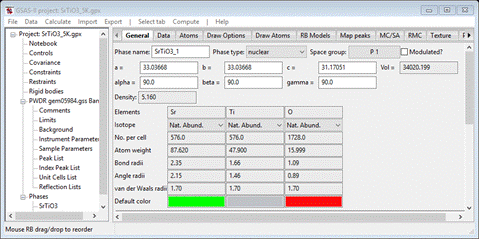
Select
the Draw
Atoms tab
for this phase; a van der Waals ball model will be drawn; scroll out (mouse
wheel) to see it more clearly. You should see something like
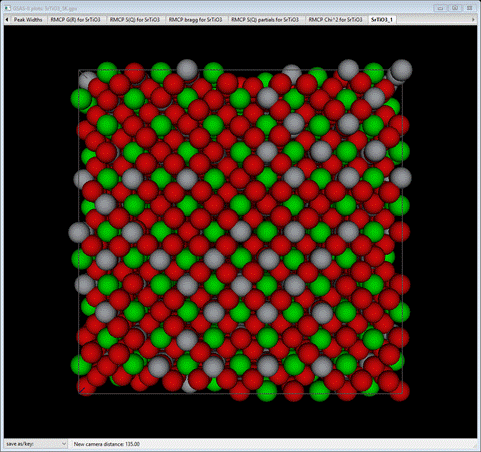
NB:
this import facility can be used to load any rmc6f file, e.g. from a RMCProfile
run done outside of GSAS-II; all the plotting and tools in this and the
following steps are available for these big box models.
Step 10. Polyhedral
comparison for the big box model
In
this step we will examine how the suite of TiO6 octahedra deviate
from an ideal octahedron. This analysis is currently restricted to structures
with P1 space group symmetry; this is what we have from Step 9 above. Select Phases/SrTiO3_1 from the data tree; the
General tab will appear.
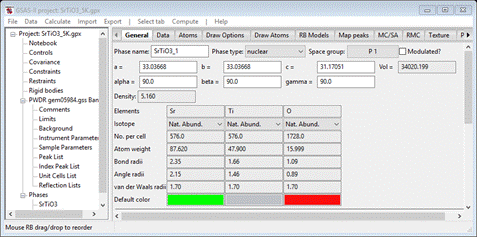
What
we want is at the bottom of this panel; scroll down to the bottom

At
the very bottom is the control for polyhedral comparison. All that is needed is
to select the central atom (“origin atom type”) and the polyhedral
vertices (“target atom type”). Select Ti for the former and O for the latter. Then do Compute/Compare from the menu; a popup for
setting Distance Angle Controls will appear
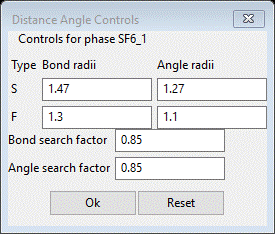
In
some cases the bond search factor may need to be adjusted to get the right
number of vertices for the polyhedral; in this case 0.85 is too large; change it to 0.79 (NB: in this use the angle
ranges are ignored). Press OK; a progress bar will show the atoms being processed. The
console will show some atoms being skipped because the number of vertices
wasn’t either 4 (tetrahedron) or 6 (octahedron). In this case it takes a while;
be patient. The progress bar will show how it is doing; it shows for all atoms
and will quickly finish after ~1150 atoms (the end of the Ti atoms). The
General tab reappears already scrolled to the bottom
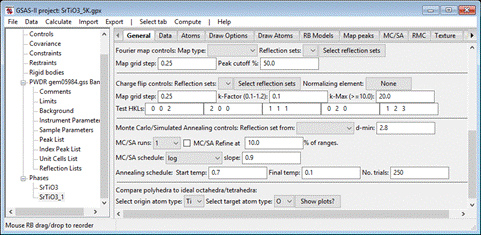
A
new button (Show Plots?) has appeared after the atom selections; press it. A number
of new entries will appear on the plot window; we will discuss each in turn.
Select the Oct-Bond tab
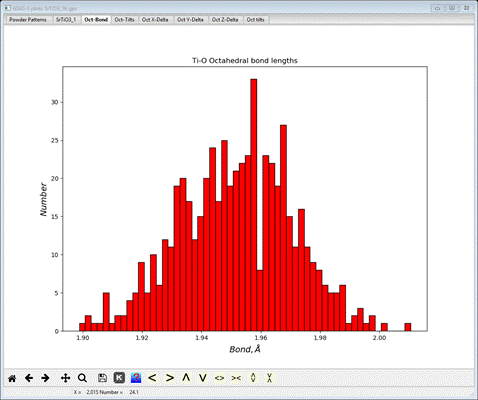
This
gives the distribution of Ti-O bond lengths for all the octahedra found across
the big box model. It is rough because of the small size of the model (the hole
at 1.96 is just a statistical accident). The console will have listed the
average value with the standard uncertainty in parentheses.

Next
select the Oct-Tilts tab
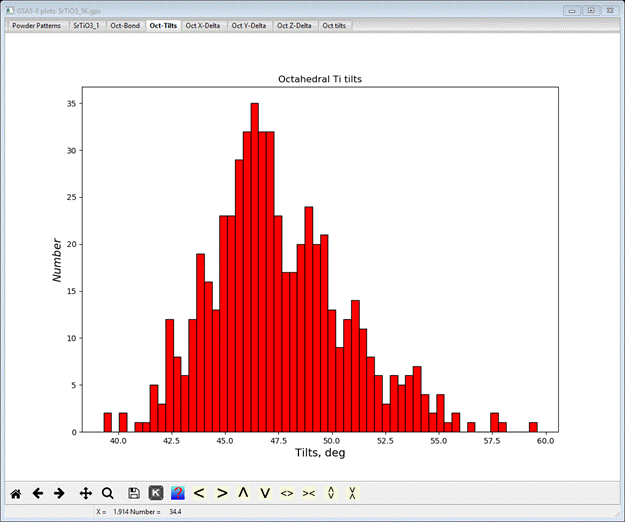
This gives the distribution of axial tilts of the TiO6
octahedra from the reference octahedron (aligned along the Cartesian axes).
There is a wide distribution with a roughly average tilt >45 deg (the
average tilt is also shown on the console); in the average perovskite structure
this tilt is exactly 45 deg so there is a subtle twist of the octahedra of ~2.5
deg from the average. Next select Oct X-Delta, Oct Y-Delta and Oct Z-Delta tabs in turn.

I
have made this plot by dragging the respective plot tabs to one of the right (or
left) edges to create a 3 pane plot. These show the displacement of the O atoms
from the ideal octahedral vertices along each Cartesian axis. Here they are
arranged about the zeros fairly tightly. If there were structural distortions
to the octahedra (e.g. Jahn-Teller distortions) these could show in these
plots. Finally select the Oct tilts tab; a 3D plot will be shown
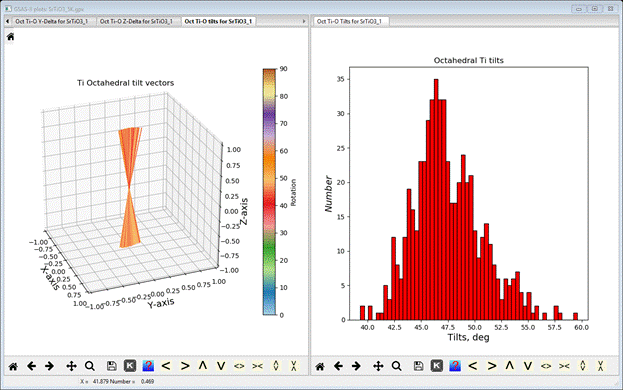
What
we see here is a fan of unit vectors along the z-axis all with about the same
color consistent with the tilt angles shown in the right hand panel. About half
are along +Z and the other half along –Z and tipped slightly about the Y-axis.
Step 10. View the
disordered average structure
We
can compress the big box result back into the original average crystal
structure to see how the disordered sites compare with the average ones. Select
the General tab for the big box phase (SrTiO3_1) and then do Compute/Transform. A popup dialog will appear
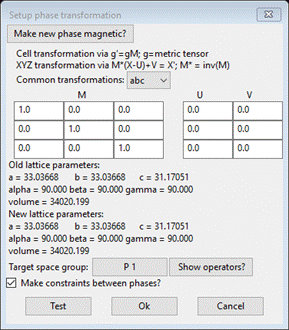
This
is the general tool inside GSAS-II for all sorts of structure transformations. Here
we will use it to push all the big box atoms back into the average structure
unit cell. Recalling that the big box model is 6x6x4 the original unit cell, we
simply want to reverse the process. Enter 1/6, 1/6, 1/4 into the diagonal elements
of the M matrix. The GUI will convert them to the decimal equivalent (0.1666…
and 0.25). The target space group should be P 1. Press the Test button; you should see

Press
Ok to do the transformation. A
new phase, “SF6_1 abc” will be formed as triclinic with cell axes that match
the original tetragonal ones. Select Draw Atoms; a van der Waals model will
appear.

Select
the Draw
Options tab
and reduce the van der Waals scale to about 0.05.
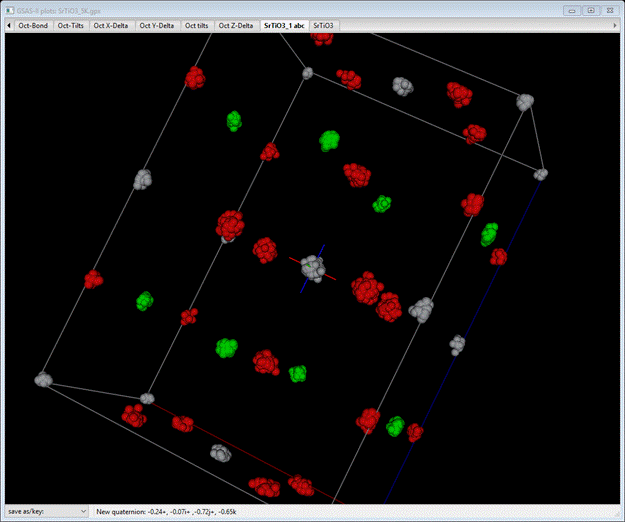
This
compares pretty well with the original structure with the ellipsoids drawn at
99% probability.
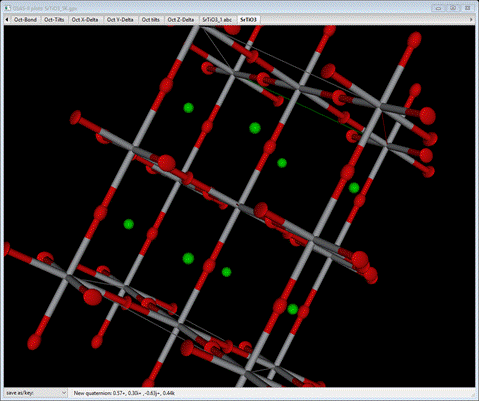
Although
it doesn’t quite capture the pancake appearance of some of the O-atom thermal
motion.
Final note
The
problem with the value of the difC diffractometer constant means that there is
an unknown small bias in the scale of G(R) and thus all interatomic distances.
This is only resolved by careful calibration of the diffractometer via known
standards using the profile functions known to both RMCProfile and GSAS-II and
the universal use of those parameters for all data reduction steps for both the
powder pattern and the F(Q) and G(R) data sets.